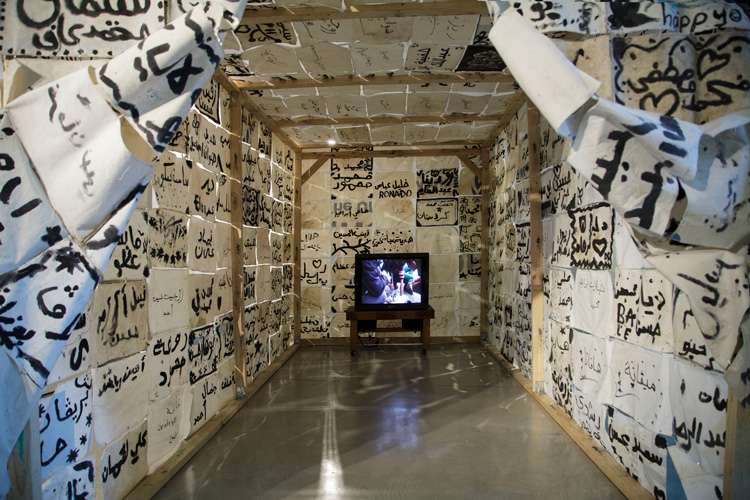PROJECT: The Patterns of Displacement

Title: “The Patterns of Displacement in Context of Home”
Medium: UNHCR tent fabric, Paint, safety pins, wood frame, and HD video one channel.
Size: Dimensions variable,
Installation view at MARS Gallery & UTS Gallery, Australia, (L 400 cmx H 200 cm x W: 200 cm)
“The Patterns of Displacement” is an immersive social installation realized with the community of Arbat Refugee Camp, in the Kurdistan region of Iraq. Focusing on the plight of its youth, this ‘tent’ reveals the names of over 280 children whose identities are largely writ invisible, within a political landscape of ongoing international calamity. As an artwork of testimony, its nature (components in pieces that are put back together randomly each time it is displayed) is representative of a collective cultural body (refugees) with little control over their fate and mobility, reduced to a statistic. Rushdi Anwar reveals the dehumanizing reality of these people, his artwork a beacon of hope in increasing awareness of their fragile existence.
From September 2016 to February 2017, I worked in several refugee camps in the Kurdistan region of Iraq. I encountered refugees from a diversity of backgrounds (Yazidi, Christian, Shabak, Sunni, Kurdish, Arab, Syrian and other minorities). The projects that I produced within the camps focused on the daily living conditions of the refugees.
For “The Patterns of Displacement”, I used a discarded official UNHCR (United Nations High Commissioner for Refugees) refugee tent that I found in Arbat refugee camp. The tent is a common object in everyday life and marks a place of family gathering and living in the camp. A refugee tailor who lived in the camp cut this tent into 285 pieces. On each piece at least one name appears. These are the hand-written names (in Kurdish and Arabic) of children who live, and attend the camp school, in this camp. These pieces of tent are joined together by safety pins, stretched over a wooden frame that returns this material to its original form – a rectangular tent. The audience is invited to walk in to this tent; at its rear is a single channel television with a twenty-minute video showing the production process of making the work. The ambient sound that emits from this video shares the sounds of children talking excitedly about how to write, of people in the background praying or children kicking balls in the dirt. Most of the youth have been in the camp for two to eight years and have been through serious trauma. They hoped for many things, but there is not much for them there.
……………………………………….
Acknowledgement:
This project has been assisted by the Australian Government through the Australia Council for the Arts, its arts funding and advisory body. It has also been supported by the Victorian Government through Creative Victoria.